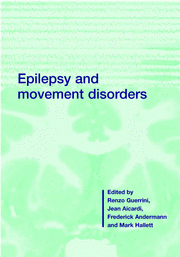Book contents
- Frontmatter
- Contents
- List of contributors
- Preface and overview
- 1 Epilepsies as channelopathies
- 2 Epilepsy and movement disorders in the GABAA receptor β3 subunit knockout mouse: model of Angelman syndrome
- 3 Genetic reflex epilepsy from chicken to man: relations between genetic reflex epilepsy and movement disorders
- 4 Functional MRI of the motor cortex
- 5 Neuromagnetic methods and transcranial magnetic stimulation for testing sensorimotor cortex excitability
- 6 Motor dysfunction resulting from epileptic activity involving the sensorimotor cortex
- 7 Nocturnal frontal lobe epilepsy
- 8 Motor cortex hyperexcitability in dystonia
- 9 The paroxysmal dyskinesias
- 10 Normal startle and startle-induced epileptic seizures
- 11 Hyperekplexia: genetics and culture-bound stimulus-induced disorders
- 12 Myoclonus and epilepsy
- 13 The spectrum of epilepsy and movement disorders in EPC
- 14 Seizures, myoclonus and cerebellar dysfunction in progressive myoclonus epilepsies
- 15 Opercular epilepsies with oromotor dysfunction
- 16 Facial seizures associated with brainstem and cerebellar lesions
- 17 Neonatal movement disorders: epileptic or non-epileptic
- 18 Epileptic and non-epileptic periodic motor phenomena in children with encephalopathy
- 19 Epileptic stereotypies in children
- 20 Non-epileptic paroxysmal eye movements
- 21 Shuddering and benign myoclonus of early infancy
- 22 Epilepsy and cerebral palsy
- 23 Sydenham chorea
- 24 Alternating hemiplegia of childhood
- 25 Motor attacks in Sturge–Weber syndrome
- 26 Syndromes with epilepsy and paroxysmal dyskinesia
- 27 Epilepsy genes: the search grows longer
- 28 Genetics of the overlap between epilepsy and movement disorders
- 29 Seizures and movement disorders precipitated by drugs
- 30 Steroid responsive motor disorders associated with epilepsy
- 31 Drugs for epilepsy and movement disorders
- Index
- Plate section
25 - Motor attacks in Sturge–Weber syndrome
Published online by Cambridge University Press: 03 May 2010
- Frontmatter
- Contents
- List of contributors
- Preface and overview
- 1 Epilepsies as channelopathies
- 2 Epilepsy and movement disorders in the GABAA receptor β3 subunit knockout mouse: model of Angelman syndrome
- 3 Genetic reflex epilepsy from chicken to man: relations between genetic reflex epilepsy and movement disorders
- 4 Functional MRI of the motor cortex
- 5 Neuromagnetic methods and transcranial magnetic stimulation for testing sensorimotor cortex excitability
- 6 Motor dysfunction resulting from epileptic activity involving the sensorimotor cortex
- 7 Nocturnal frontal lobe epilepsy
- 8 Motor cortex hyperexcitability in dystonia
- 9 The paroxysmal dyskinesias
- 10 Normal startle and startle-induced epileptic seizures
- 11 Hyperekplexia: genetics and culture-bound stimulus-induced disorders
- 12 Myoclonus and epilepsy
- 13 The spectrum of epilepsy and movement disorders in EPC
- 14 Seizures, myoclonus and cerebellar dysfunction in progressive myoclonus epilepsies
- 15 Opercular epilepsies with oromotor dysfunction
- 16 Facial seizures associated with brainstem and cerebellar lesions
- 17 Neonatal movement disorders: epileptic or non-epileptic
- 18 Epileptic and non-epileptic periodic motor phenomena in children with encephalopathy
- 19 Epileptic stereotypies in children
- 20 Non-epileptic paroxysmal eye movements
- 21 Shuddering and benign myoclonus of early infancy
- 22 Epilepsy and cerebral palsy
- 23 Sydenham chorea
- 24 Alternating hemiplegia of childhood
- 25 Motor attacks in Sturge–Weber syndrome
- 26 Syndromes with epilepsy and paroxysmal dyskinesia
- 27 Epilepsy genes: the search grows longer
- 28 Genetics of the overlap between epilepsy and movement disorders
- 29 Seizures and movement disorders precipitated by drugs
- 30 Steroid responsive motor disorders associated with epilepsy
- 31 Drugs for epilepsy and movement disorders
- Index
- Plate section
Summary
Introduction
Sturge–Weber syndrome (SWS), is a sporadic, congenital, frequently progressive, neurological disorder classically characterized by the association of a congenital facial capillary angioma with leptomeningeal angiomatosis. Epilepsy, mental retardation, and focal neurological deficits are the major neurologic abnormalities (Alexander & Norman, 1960; Alexander, 1972; Gomez & Bebin, 1987). The motor attacks include, in addition to epileptic seizures, transient hemiparesis or hemiplegia, often leaving a definite neurological deficit. Other features of the syndrome include hemiatrophy, homonymous hemianopia, glaucoma, dental abnormalities, and skeletal lesions (Roach & Bodensteiner, 1999).
Vascular abnormalities
Although the cutaneous capillary angioma is the hallmark of the SWS, most children born with facial port-wine stains do not have the syndrome. The SWS facial angioma is classically found on the forehead and upper eyelid. For a patient with any facial port-wine stain, the risk of having the SWS is only about 8%. It increases to 25% when half of the face, including the ophthalmic division of the trigeminal nerve, is involved (Morelli, 1999). Intracranial leptomeningeal angiomatosis is almost always ipsilateral to the cutaneous nevus. Exceptions to the rule are not infrequent and the correlation between the extent and location of the naevus and that of the pial angioma is poor (Alexander, 1972; Gomez & Bebin, 1987; Pascual-Castroviejo et al., 1993). Some children have bilateral nevus with unilateral pial involvement or vice versa. Angiomas may extend beyond the face and involve the neck, trunk or limbs on one or both sides (Uram & Zubillaga, 1982). In a recent series of 20 surgically treated SWS patients, six presented with extensive cutaneous angiomatosis, which was bilateral in three (Arzimanoglou et al., 2000).
- Type
- Chapter
- Information
- Epilepsy and Movement Disorders , pp. 393 - 406Publisher: Cambridge University PressPrint publication year: 2001



